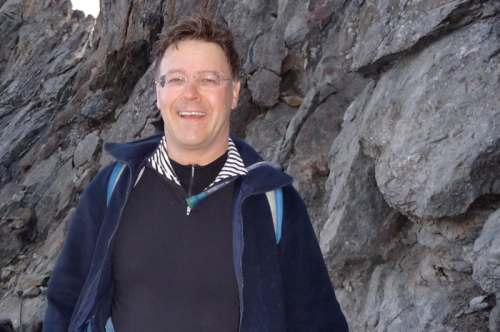“The world has a lot of work to do”
29 September 2016
How did ING’s view on sustainability shift from what we shouldn’t do to what we should, and how can we measure whether we’re doing enough? ING’s head of Lending Services, Christopher Steane, explains.

Christopher Steane, here on Mont Vélan, Switzerland: “Mankind should in effect stop using an extremely convenient energy source, which powered most of our economic growth to today.”
Christopher Steane has solar panels on his house, but doesn’t drive an electric car (only because he’s had the same car for 16 years). He likely inherited his delight in the natural environment from his father, who was a very ‘outdoors person’, and he’s a diligent advocate of all sorts of recycling.
He’s also a banker through and through—with ING for nearly 40 years.
ING’s Wholesale Banking head of Lending Services Christopher Steane is the man behind ING’s push to increase the ‘sustainable transitions’ we finance (STF), which is ING’s way of measuring both clients who are sustainable outperformers and transactions for sustainable projects (i.e. renewable energy, low-carbon transport, social welfare).
ING announced with our second-quarter results in August that we aim for EUR 35 billion in STF by 2020, up from EUR 27.8 bln on 30 June 2016.
How does ING make its loan book more sustainable?
“Years ago ING began developing policies that told us not to do certain things, like supporting businesses that were illegally logging the rainforests and operating projects in environmentally sensitive areas. These are good policies—but all telling us what not to do. So I asked the teams, can you think of an approach that reverses that and focuses on whether there are things we should positively be doing.
“One thing you could do is say I’ll hire a sustainable finance team, put them in a box with a green door and they can finance windmills and we’re done. What we wanted to do is say these themes are wider and we want to involve everyone. Then we started thinking, how can we even begin to measure this.
“We decided to use the word sustainable ‘transitions’, because absolute sustainability can be a contested description. We want to help society make a transition. And it’s wider than just transactions, it’s about supporting the most sustainable clients as well.”
So, why this target?
“Initially, we wanted to see how much of the portfolio qualified. When we first did it at the end of 2014 it was 14% or 15%. It’s gone up since then as more transactions have qualified and as we’ve completed the assessment of the client portfolio.
“We had a metric and were beginning to get a feel for how we were doing; what our starting position was. Then we set a target for 2020 and obviously, inevitably, it’s a stretch. You have to get the ambition level right. If it’s going to happen anyway it’s not ambitious but if it’s too high it’s meaningless.
“You need to make an assessment of where you think it’s acceptable to ask the organisation to stretch to. We decided to go for 20% of what we expect the Wholesale Banking portfolio to be at that time, or EUR 35 bln.”
Is this enough?
“Because the tests are high hurdles, we’ll never target 100%, nor do I think it’s appropriate. We are a bank for society as a whole. We support economic activity across the societies in which we operate. It’s not easy to decide we’re just not going to finance large sectors.”
How do we compare with other banks?
“Certainly other banks have targets. But the approach we’re taking to involve businesses across the board is in advance of most banks.”
Looking at 2020, is this going to make the difference you hope for?
“Progress never goes quickly enough. We’ve come a long way but I’m quite certain there’s an awful lot more we can do.
“The world has a lot of work to do, because even the plans that emerged at the Paris conference aren’t big enough to meet the aim of limiting carbon dioxide emissions. Mankind should in effect stop using an extremely convenient energy source, which powered most of our economic growth to today. That’s unlikely to happen immediately.
“With this target we show that we want to do our part and more: by 2020 I hope we will have established ourselves as leader among financial institutions in this area.”
What do you say to retail customers who want ING to invest their money sustainably?
“It’s shifted. As individual members of society we expect companies that provide goods and services to behave in environmentally responsible ways. The primary obligation we have is to invest savings safely and securely. Sustainability is on top of our criteria list. We are here with a desire to help society make the transition to a more sustainable economy and to do our part in helping to finance that. Still, we’re a business, not a charity.”
